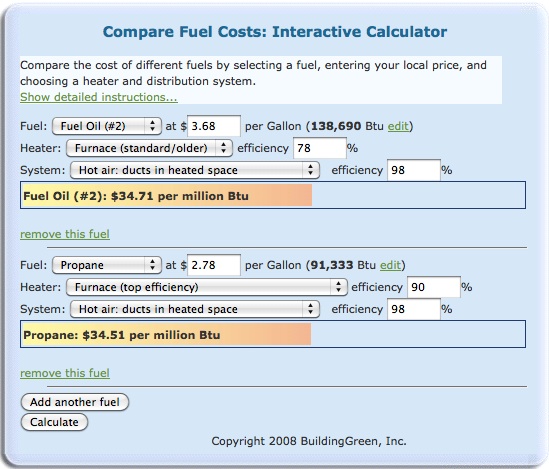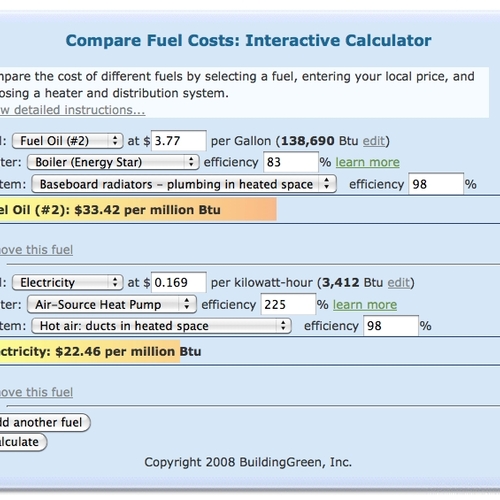
Image Credit: BuildingGreen.com
I recently caught up with where the rest of the world was in 2005 by watching the hit documentary “March of the Penguins.” It’s been on my list for a while but when evening arrives I’m much more prone to watching films about people — people like James Bond, for example. But my wife and I had a baby two weeks ago, and suddenly movies narrated by Morgan Freeman seem like more appropriate family fare.
My only quibble with the movie is the name: it would be more accurate to call it “Commute of the Penguins.” I had understood that the movie was about this extraordinary 70-mile walk that Emperor penguins undertake once a year to get to their Antarctic breeding ground. I learned from the movie, though, that they go back and forth several times, with the parents taking turns to get food while the other does childcare. (Tip to dads: don’t let your offspring freeze while mom is out catching fish for dinner.)
Is there a better heating fuel out there?
The cold endured by these penguins got me thinking about heating fuels. With home heating fuel prices bouncing up and down as much as they have over the last few years, it’s easy to think that there must be a better solution out there, with a different fuel. But is there? Some cost calculations will help us answer that question.
Let’s check on the prices of major regional heating fuels. According to the Department of Energy, the average price this month for residential heating oil is $3.68 per gallon (wholesale is $2.97). Residential propane costs $2.78 per gallon ($1.52 wholesale). This varies all over the map, but the most common price I am seeing for delivered cordwood is $250 per cord. Wood pellets are priced at about $270 per ton. Electricity here in southern Vermont currently costs 14 cents per kilowatt-hour, but it’s all over the map (literally) across the country.
Heating value and per unit of fuel varies
By themselves, these cost figures don’t mean much because the heating value, or BTUs, contained in a unit of each fuel is so different. For example, one gallon of fuel oil contains 0.15 million BTUs, while one gallon of propane contains 40% less: 0.091 million BTUs.
Efficiency of consumption varies a lot too
Also, the amount of useful heat obtained from a given fuel depends on how efficiently it’s consumed. Combustion efficiency varies widely — from as low as 30% for the worst of the outdoor wood boilers to over 95% for a top-efficiency, condensing gas boiler. Heating with electric baseboard heaters is 100% efficient. (Keep in mind that most electricity comes from coal or natural gas, and utilities are only about 30% efficient in converting those fossil fuels into electrons delivered to your home.)
Buildings using electric heat pumps have much higher efficiencies (typically 200%–300%), because electricity is used for moving heat from one place to another, rather than being converted directly into heat.
… And don’t forget efficiency of distribution
To further complicate fuel cost comparisons, a third factor is how efficiently heat is distributed. With electric baseboard radiators, the heat is produced right in the room, so the distribution is 100% efficient. Baseboard hot water (hydronic) heat is also usually very efficient, though uninsulated hot water pipes running through an unheated basement can lower that efficiency.
With a hot-air furnace and ducts to carry the heat, however, the distribution efficiency can be quite low, especially if poorly insulated, leaky ducts run through an unheated attic or crawl space — distribution efficiency as low as 60% to 65% is not uncommon.
To calculate the actual delivered efficiency of your heating system, you have to multiply the combustion efficiency by the distribution efficiency. For example, if you have a 78% efficient oil furnace and a relatively leaky duct system running through an unheated attic (65% efficient distribution), your overall efficiency of delivered heat is just over 50% (0.78 x 0.65) — meaning that only half of the energy you’ve paid for is actually being used to keep you warm!
Combining factors into one easy comparison
In order to combine all these factors into a meaningful comparison of heating fuel costs, it’s easiest to use an online comparison calculator like one offered by BuildingGreen.
This allows you to enter your cost for a particular fuel, your heating system efficiency, and its distribution efficiency. The end result is a figure in dollars per million BTUs that reflects your real costs of delivered heat and allows you to compare that with other options.
Example: Switch from oil to propane?
I know someone who heats with oil, paying $3.68 per gallon, and uses an older forced-air furnace with roughly 75% efficiency. The heat is distributed through ducts that run through the heated space, with roughly 98% efficiency. Using the online calculator, we can see my friend is paying $36.10 per million BTUs.
Let’s say he wants to upgrade to propane in order to take advantage of the more stable prices, and the 90% efficiency offered by good propane furnaces. With the same ducted distribution, he would be paying $34.51 per million BTUs.
Switching to propane would, in this case, save some money, but not a huge amount, and particularly with fluctuating prices a fuel switch here would be debatable on cost grounds. On a carbon comparison, however the higher efficiency, cleaner-burning propane would be an improvement. I might advise this friend to switch now if he felt really motivated by that, but otherwise to get more life out of his current furnace and in the meantime, work on air sealing and other cost-effective efficiency measures.
What are you heating with, and what are you considering switching to? Check out our free online calculator at BuildingGreen.com/calc/fuel_cost.cfm and let me know what you think.
Tristan Roberts is Editorial Director at BuildingGreen, Inc., in Brattleboro, Vermont, which publishes information on green building solutions.
Weekly Newsletter
Get building science and energy efficiency advice, plus special offers, in your inbox.















2 Comments
More than just price
This is a great piece that should help homeowners and building owners realize that the price of a given fuel type should not be the only measure when determining whether to install a new heating system. Efficiency plays a very big role in the picture. The BuildingGreen calculator you linked to should be a good initial guide for people. Thanks for providing this.
helpful tool from DOE
I use http://www.eia.gov/neic/experts/heatcalc.xls
for energy auditor instruction, and
http://www.energyexperts.org/CalculatorsTools/HeatingCostCalculator.aspx
is a nice tool.
BuildingGreen's inclusion of distribution efficiency is a valuable supplement.
It is important to observe +/- 20 to 40% year-to-year changes in utility prices, which I track at
http://www.citizensutilityboard.org/ciNaturalGas.html
Log in or create an account to post a comment.
Sign up Log in